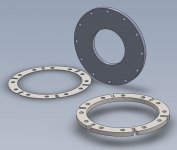Certainly, there is nothing wrong with wishing better balance. The weight washers are a great idea. I don’t always balance wheels but do side dress some wheels needing better surface finish.
Mach B was originally in Warren Michigan just a mile and a half north of Detroit, and was our source for wheel alterations. It was one of my tasks to take wheels there for altering and speed testing if a wheel needed to be certified for another speed, came in with no markings, and/or reshaping.
Vitrified wheels were crushed to make steps and other alterations like width and diameter. I can’t remember ever having them a wheel but likely that was also a service provided. A small mild steel cup was mounted to a spindle and pushed hard against the wheel. Vitrified being melted glass holding the wheel grits together would let loose and the new wheel shape would be made.
Back to thinning it is good to consider the diamond position and angle to not thin the diamond shank to not loosen the diamond, to dress on the down side so pushing the diamond hold down to the chick or holding fixture, to up feed the diamond a few times so using the point/not the side of the diamond.
Testing the slot width is important because some material may expand into the wheel and some wheels tend to cut wide or narrow to the measured width, so giving a wider slot than desired. Often I would keep a clay wheel for finishing the bottom. corners, and sides to print needs.
Good to test the slot with a jo-block so location and size can be monitored.
Tweaking the wheel width with a cross feed is tricky. Wheels don't cut well with pressure to the side. Often very fine feeds are needed, perhaps only few tenths or microns with each feed and the perhaps a few free passes to spark out..Burning also comes with side grinding a fine grit whee so it doesn't hurt to use coolant for the task. blue-up or grease pencil up is often good.
It is good to consider the slot bottom corner (s) so adding extra depth for the corner radius even if it is only a few microns..many if not most deigns are better served with extra clearance at the bottom of a slot..Yes the mating part can be beveled so adding another operation
Mach-B Grinding Wheel Shaping & Resizing – Winona, Minnesota
Anatomy of a Grinding Wheel : Mach-B Grinding Wheel Shaping & Resizing
(PS ask them if anyone remembers Buck}



